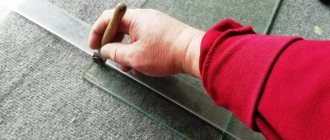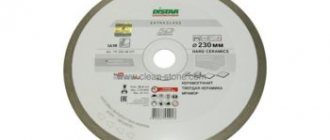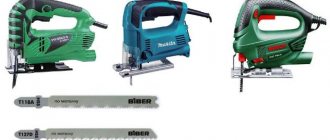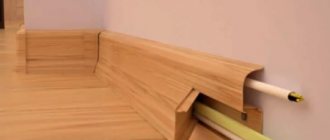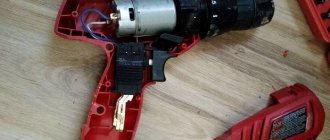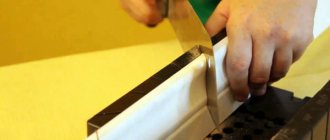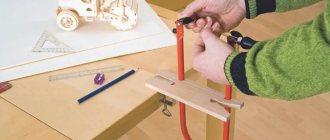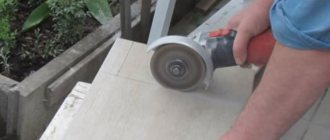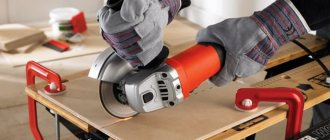Shaped cutting of porcelain tiles
Hole saw
If you need to cut porcelain stoneware into straight lines, then the choice is quite wide, but with curved cuts it is a little more difficult.
The scope of use of a hole saw equipped with a carbide tip also extends to porcelain stoneware. It is also used to create rounded holes in hard materials such as cement tiles and stone. A hole saw can cut any quality of porcelain tile: soft or hard, but cutting tiles with a glazed surface is slow. Advantages: the most effective option for obtaining round holes, working with various building materials. That is, if necessary and for performing specific work with porcelain stoneware, a hole saw will be useful.
Disadvantages: in some cases, processing takes a long time, and porcelain stoneware is subject to strong thermal influences.
Wire cutters
Of all the cutting devices, this is the simplest. It is sometimes very difficult to do without nippers when laying porcelain tiles in residential premises. Most often, nippers are used for cutting porcelain stoneware with irregular shapes.
Advantages: relatively cheap option, the ability to cut various materials to produce cutouts with a variety of shapes.
Disadvantages: bitten edges leave uneven surfaces, which later have to be sanded.
Ballerina
This tool specializes in rounded holes in porcelain tiles. The main advantage of the ballerina is that the characteristics of the planned hole can be different, since the parameters of the incisors are adjusted manually. But the ballerina cut usually comes out uneven and curved, so it is not often used when processing tiles, although special attachments for porcelain tiles are also sold on the market. In addition, centering the device is quite difficult, which can cause damage to both the ballerina and the tile.
Mechanical tile cutter
Cutting porcelain tiles with a manual tile cutter is not very easy, but it is quite possible. You just need to make sure that its design is designed to work with tiles of large thickness and large sizes. It must have sufficient lever travel, a strong and wide frame, and a long and strong handle.
If you see that the tile cutter does not cut, but only slightly scratches the porcelain stoneware, you should sharpen the cutter or even replace it with a carbide cutter made of good tool steel.
The procedure for cutting porcelain tiles with a tile cutter is as follows:
- Draw a cutting line.
- Place the tile on the frame so that the device rollers rest on it.
- Move the lever away from you to make a cut.
- Lowering the lever, break the porcelain tile along the cut line.
Mechanical tile cutter
Before starting work, it is worth practicing on scraps. Working with a manual tile cutter will require significant physical effort and a significant investment of time.
Video: How to Cut Porcelain Tile with a Glass Cutter
A shredder is a potentially dangerous tool, so don't ignore safety rules. Safety equipment should be considered. The kit includes:
- Wear a respirator because cutting creates a lot of dust.
- Safety glasses to prevent splinters from entering your eyes.
- Workwear.
- Headphones or headphones that protect your hearing from loud noise.
It is not recommended to neglect protective equipment, even if you plan to cut several plates.
Correctly cutting porcelain tiles using a grinder is quite simple if you follow the instructions:
- We are preparing a place to work. Place a backing sheet on a flat surface to protect the base. You can choose foam, foam, etc.
- Place the piece face up on the base and trace the cutout area on it. To reduce the number of chips, place a strip of adhesive tape on it and run the cutting line along it.
- We place the metal corner on top of the tile along the cut path and secure it with clamps. This will allow you to cut accurately. This should be done when cutting thick products.
- We start the grinding machine. We immediately cut out the part, directing it away from us. To get a smooth edge, cut the piece so that the marking line remains on the product. This will be removed during sanding and the tile will remain the specified size.
- Remove the adhesive tape and sand the end of the part if necessary.
If a thin or perfectly straight cut is not required, you can simplify your job. The chopper does not cut, it only cuts. Then the fragment comes off with a sharp, strong movement.
It is very convenient to use a grinding machine to cut porcelain stoneware. First of all, because it is the most affordable of all the devices that can be used. They can make cuts of various shapes, including any curved ones
However, the coffee grinder is traumatic; you need to work very carefully. It is very dusty and noisy
READ How to Make a Screwdriver Directly from the Network
Features of the material
The raw materials, consisting of clay, kaolin, quartz sand, feldspar and mineral additives, are pressed under high pressure and then sintered at high temperatures. The resulting material has virtually no pores and has a hardness equal to that of corundum (7 – 8 on the Mohs scale). It is inferior in hardness to only a few materials, such as diamond, sapphire, ruby, etc. At the same time, thin tiles (3 mm and thinner) are quite fragile.
Note! Cutting material of such hardness will not work with hand glass cutters, stone blades or jigsaws. They can only be used as an auxiliary tool.
Let's look at two ways to cut tiles at home. The methods have limitations, which will be discussed below, as well as ways to circumvent these limitations. They can achieve acceptable results, but it is better to cut porcelain tiles using professional equipment. Only it will give a guaranteed result in an acceptable time with a relatively large amount of work.
Forming holes
It is advisable to form small-diameter holes using drills with a Pobedit tip. This approach is relevant for diameters up to 12 mm with tiles. A drill or hammer drill is selected/adjusted to a power of 800 W. The chuck must be centered to avoid hitting the tile. If the surface is smooth, then 4-5 pieces of masking (paper) tape are glued onto it to prevent the drill from slipping.
Standard holes with a diameter of up to 50 mm are drilled with crowns with pobedit cutting edges. It is better if they are equipped with a centering drill. It will not allow the cylinder to move away from the intended lines. The cutting begins at low speeds until a starting groove is formed with a depth of 3 mm. Then the speed can be increased.
Drilling with a crownSource recn.ru
Non-standard holes in size (55, 68, 71 mm) are made with a ballerina. This is a Device with a centering drill, on which the cutter is attached by means of a rod. The distance between the elements is adjusted; the clamp is a clamping screw. The latter is considered the weakest point of the equipment, but insufficient tightening of the structure leads to disruption of the correct drilling process.
Drilling with a ballerinaSource remontpro.pro
It is often necessary to design inlet openings for sewer or ventilation pipes with a diameter of over 100 mm. Here they resort to a grinder with a diamond blade. It is less common to cut with the side edges of the disc without a protective casing. More often, individual notches are made, the tiles are broken with nippers or pliers, and the edges are sharpened with a file or disk. The third option is an electric jigsaw.
How to remove chips on a cut rib
Even good craftsmen are not always able to make a perfect cut. Sometimes the reason for this is the structure of the tile itself, sometimes it is the low quality of the cutting tool. It doesn’t matter why your porcelain tiles have chips. If this edge is visible, it becomes necessary to grind this edge, make a chamfer, or in some other way get rid of this small defect .
First, you can remove the layer with a rough stone cutting wheel (not a diamond one), and then polish tenths of a millimeter with a diamond grinding wheel, which is popularly called a turtle wheel.
Depending on the grain size, these wheels are marked, just like sandpaper. They can not only sand, but also polish your edge to perfection. In some cases, for example, if the cut has a concave shape, it is difficult or impossible to process the end of the cut with a grinder. Then a diamond-coated sponge will come in handy. By slightly moistening its surface, using circular movements, you can bring the end of the product or chamfer to high quality.
Video:
Video:
Briefly about the main thing
To cut tiles at home, use tools with carbide cutters, rollers or replaceable discs.
Porcelain tiles are practically not cut with a glass cutter. They resort to a manual tile cutter.
With replaceable diamond wheels, it is permissible to use a grinder, a circular saw, or an electric tile cutter.
Artistic cutting can be done with a hand jigsaw with diamond wire or a more advanced water jet machine.
Holes in the form of a circle are formed with drills, crowns or a ballerina. For large diameters, use a grinder or jigsaw.
How to make holes in porcelain tiles
During construction and renovation, it is often necessary to make a hole in the tile for supplying communications or installing equipment. In this case, specialized tools come to the rescue.
Ballerina
Most of all, the device resembles a compass. One leg rests on the center of the future hole, it is clamped in the drill chuck. The other can change its reach by moving along the horizontal bar. A carbide cutter is attached to its end.
Ballerina
When the drill is turned on, the central leg is held in the center of the future hole, and the leg with the cutter, rotating, scratches the tile to a sufficient depth.
Next, use a mallet to knock out the cut circle and grind the edges of the resulting hole.
Diamond crowns
The industrial diamond-coated bit cuts exceptionally straight holes and does not require much effort.
There is only one minus - it will not be possible to make a hole of any diameter. Crowns can only be of certain sizes. The tool shank is also attached to the drill chuck, and the central drill is positioned at the marked point. You should work at the highest speeds.
Both the ballerina and the diamond crown should only be used on the front side of the tile. Otherwise, chips are inevitable.
Power tools for cutting porcelain tiles
Power tools in the form of:
- electric tile cutter;
- Bulgarians;
- jigsaw;
- circular saw;
- drills with ballerina;
- waterjet installation.
Electric tile cutter
Diamond coating on the electric tile cutter disc allows you to cut porcelain tiles of different thicknesses and lengths. There are different models of such tools: in some, a disk moves along the tile, in others, a table moves with the help of a motor.
The advantage of this tool is that it uses so-called “wet cutting discs”, that is, water is used to reduce the formation of dust while cutting tiles. In some models, a container of water is installed under the disk, into which the disk itself is partially immersed. For others, the disc is wetted with running water.
IMPORTANT! When working with wet cutters, you need to monitor the degree of contamination of the disk, clean it in time and change the water, otherwise the quality of the cut may significantly decrease
Bulgarian
You can also cut porcelain stoneware at home with a grinder. To do this, you need to purchase a diamond-coated disc with a thickness of 2 mm and an edge width greater than the thickness of the porcelain stoneware.
REMEMBER! When working with an angle grinder, you should install the disc with the correct side and be sure to protect your eyes with glasses, since many chips are formed during processing. Cutting should be done in one step, otherwise the cut will be uneven. You also need to leave a margin of a few millimeters for sanding the edge.
Jigsaw
This tool is suitable for cutting porcelain tiles with a small thickness. To do this, you need to take a diamond-coated thread.
A circular saw
Refers to professional equipment and is used for large-scale processing of ceramic tiles. During the cutting process, tiles must be fed manually, which increases the risk of injury.
This saw is not always suitable for cutting porcelain stoneware at home. Before making a choice, you need to weigh how useful it will be in the future; it may be easier to get by with improvised tools, for example, a grinder.
Drill
No matter how strange it may sound, an electric drill is often used to cut porcelain stoneware. Using a “crown” or “ballerina” attachment, you can make a round hole of the required diameter in the tile.
The crowns have a given diameter, and the ballerina works like a compass, so it is used to make a large hole.
Waterjet unit
This tool is used in industrial enterprises. Tile cutting is carried out with a mixture of water and solid crumbs, the thickness of the jet is tenths of a millimeter.
In conclusion, we can say that there are many tools suitable for cutting porcelain tiles. Which one is preferred depends on the volume of the tile and the frequency of its processing.
If this is a one-time cutting for finishing small rooms, then it is better to use electrical appliances already available at home, such as an angle grinder or electric saw. If you plan to continue processing ceramic tiles in the future, then it makes sense to purchase special equipment.
Disadvantages of porcelain stoneware coatings
In order to cut porcelain tiles correctly, you should know about its disadvantages:
- High price. Due to the complexity of high-pressure pressing machines. It should be taken into account that natural stone will cost more.
- High thermal conductivity. The floor will be cold on your feet. This disadvantage is combated by installing heated floors.
- Slippery surface. This is especially noticeable in damp rooms; tiles with a rough surface texture are recommended for them.
Cutting ceramic granite with a jigsaw and circular saw - features
A jigsaw with diamond wire makes it possible to perform complex shaped processing of products that interest us. It is rarely used by home craftsmen, as it requires certain skills in using such a tool. However, there is nothing difficult in its use. You only need:
carefully monitor the movement of the wire (first mark the contours of the cutout you need on the tile); constantly blow off dust from the surface of the workpiece (in this case, the cutting thread will follow a clean line and cut the material efficiently); Moisten the porcelain tiles a little with water; pay special attention to processing the edges of products where there is a high risk of chipping.
Processing the edges of the product from chipping Direct cutting of a large number of tiles can be done with a circular saw - a unit with a gear-type disk, which many home craftsmen have. You need to mount a disk (diamond) on such an installation, with which you can carry out dry cutting.
The principle of using the “circular” is as follows:
- mark the cutting line;
- press the ceramic granite product to the work surface with both hands;
- move the tile forward onto the rotating disk.
Using a circular saw requires maximum care. The tiles have to be moved manually, which can lead to serious injury to your fingers. Be extremely careful when working with this tool!
- www.ivd.ru
- septik.guru
- remoskop.ru
Circular saw and jigsaw
If we talk about available tools, then often the farm has a tool such as a circular saw, especially if we are talking about those who have their own household plot. Using a circular saw, as it is affectionately called by people, you can saw off porcelain tiles along the required line. However, the toothed disk of the tool will have to be replaced with a diamond-coated one. Act as if you are about to saw wood and take care of your fingers, then everything will definitely work out as it should.
Photo from the site: ytimg.com The second option is a jigsaw, for which you will have to buy special components in the form of a diamond thread. With such a cutting edge, you can get shaped cuts, not just straight ones. Simply draw the desired shape, and then carefully saw through the porcelain tiles, moving forward slowly and smoothly. Breaks and jerks should never be allowed, otherwise you can not only damage the tile, but also get injured if the thread breaks, which is unacceptable.
For which tiles is the glass cutter not suitable?
The use of a glass cutter is justified only for glazed varieties of tiles, the surface of which resembles glass in structure and appearance. Restrictions also apply to the thickness of the tile product - its maximum values should not exceed 5 mm.
It is impossible to process mirror tiles with a glass cutter. Its dimensions and laying pattern are selected in such a way that solid elements are used.
Gypsum tiles are not recommended for processing - their rough coating will be difficult to cut, crumble and delaminate. Porcelain tiles with a high wear resistance class (two or higher) would not be the best option. These are durable and rigid types of materials such as porcelain tiles and floor tiles.
About porcelain tiles
Porcelain stoneware is a decorator’s dream come true about a material that combines the properties of ceramics and natural stone. Obtained by pressing powder from clay, sand and kaolin, ceramic granite fired in ovens has high decorative and performance qualities. The nature of production allows us to produce tiles of any color by introducing coloring oxides into the composition and any texture: glazed, matte, polished, structured. The material is stronger than granite, it is resistant to wear and aggressive environments.
The decorative panel is inscribed in the main background. The work was carried out cutting tiles - porcelain stoneware
How to properly cut tiles with a manual tile cutter
This procedure can be performed without any problems, just follow the manufacturer’s instructions.
Sequence of operations:
- mark the cutting line. This can be done with a felt-tip pen or pencil, marker - depending on the surface of the product. For models with a laser pointer, this item can be skipped;
- The tile is fixed on the platform so that the cutting line and the wheel align as accurately as possible. If you need to make a cut diagonally or at an angle, it is convenient to use a model with a square and corner markings. If you use a simple device, without supporting corner sides, simply turn the tile into the desired position;
- by moving the carriage, an even cut is made to the end of the tile;
- lower the lever, thereby pressing on the tile on both sides of the cut. The ceramic splits along the cut line.
If the leverage is not enough, you can lay the tile on the floor, placing a narrow bar under the cut line, and simultaneously press (step on your feet, place heavy objects) on both sides of the cut.
Important: increasing the distance from the cutting line to the load application points, of course, increases the leverage and reduces the impact force. But at the same time, this increases the risk of the panel breaking not due to a cut, but arbitrarily.. As always, there are certain nuances:
As always, there are certain nuances:
- the cut is made once, it is not worth running the cutter several times in one place - the break will be uneven, with jagged edges;
- the force applied to cut the glaze must be strictly measured, as well as the force on the lever to break the panel. It is better to practice on waste or unnecessary trimmings before performing important work;
- play of the cutter (wheel) and its incomplete mobility (jamming, jerky movement) are unacceptable, the device must be adjusted and lubricated before starting work;
- Before cutting, you should check the cleanliness of the platform (presence of debris, splinters, large dust) and its stability.
Porcelain tiles should be cut according to the same principles, making allowances for the greater strength of the material. It may take more force to cut and break the panel.
In addition, a short video about exactly how a standard manual tile cutter works.
Electric tile cutter
The mechanization of production processes is designed to relieve the worker from monotonous repetitive movements and excessive physical effort. It is this effect that will be observed in the case of using an electric tile cutter. Electric tile cutters can be in one of three versions:
- compact;
- ordinary;
- cantilevered.
Compact and regular ones are cheaper, but for porcelain stoneware it is better to use a cantilever type. With it you will get not only straight cuts, but also lines of arbitrary shape. If possible, it is better to use a tool with a wet cut (the cutting disc is immersed in a tray of water), this will rid the work area of dust and absorb the energy of possible fragments.
If the device is equipped with an automatic fluid supply device, do not forget to regularly replace it with a clean one. This way the cutting organ will last much longer.
Electric tile cutter
To cut a tile, it should be secured to the bed, mark a cutting line and run the edge of the disk along it. On compact devices you will have to feed the tiles manually; here it is important to ensure that there are no distortions.
Porcelain stoneware cutting technologies
Let's look at the technologies for cutting porcelain stoneware using the most popular tools.
Manual tile cutter
Despite its simplicity, a manual tile cutter provides a fairly high quality of work. The tool consists of a support platform, two guides, thanks to which the cut is perfectly smooth, a lever with a cutting roller and clamps for breaking the tiles.
The manual tile cutter is suitable for tiles with a thickness of 8 mm, 1 cm, etc. (up to 12 millimeters). Please note that the thicker the tile, the larger the cutting roller should be in diameter. Ideally, these two values should coincide.
Preparing the tile cutter for work
Before starting work, you need to make sure that the cutting roller is not dull and its size corresponds to the thickness of the selected tile. If necessary, the roller is replaced.
The ease of movement of the tile cutter along the guide rods is determined. If the cutting element passes tightly or, on the contrary, dangles, it is worth checking the bearings and cleaning the guides.
Cutting porcelain stoneware
The cutting technology on a manual tile cutter is quite simple.
- After taking measurements, make appropriate marks on the tile with a pencil or marker;
- the tiles are laid on the tile cutter platform, the cutting line is aligned with the cutting roller;
- so that the tile does not move during cutting, it must be fixed by hand;
- the roller is installed on the edge of the tile and, gently pressing the lever, it is drawn along the entire cut line;
The smoother you move the roller, the better the finished cut will be.
- after the cut is made on the tile, it is secured to the platform with fixing tabs so that the cut line is between them;
- They begin to press on the part of the tile protruding beyond the platform with their hand until the tile breaks.
When cutting with a manual tile cutter, the edges of the tiles are quite smooth, but the appearance of small chips and unevenness is possible. In this case, the deformed edge must be sanded.
Video: how to cut porcelain tiles with a manual tile cutter
We offer you a master class on cutting porcelain tiles with a manual tile cutter.
Bulgarian
A grinder can cut a wide variety of materials, porcelain stoneware is no exception.
Preparing for work
To cut porcelain stoneware, a special “diamond blade” must be installed on the grinder. When installing the disk, check that it is securely fastened, and be sure to wear safety glasses and gloves.
Working with an angle grinder
The technology for cutting porcelain stoneware differs little from cutting other materials.
Markings are applied to the tile with a pencil along which the cut will be made;
Using a grinder you can make shaped cuts and even holes
- The tiles are cut along the marked line with a grinder. To reduce the number of chips, try to cut the tiles “in one go”;
- Since when cutting porcelain stoneware with a grinder, small chips and cracks may remain on the edges and front side of the tile, the end of the tile after cutting is cleaned with sandpaper or a grinding disc.
Video: how to cut porcelain tiles with a grinder
Electric tile cutter
If the two previous methods are considered within the framework of “dry” cutting, then the next technology refers to “wet”. In other words, during the process, water is supplied to the tile cutter, which protects the cutting element from overheating. This ensures an almost perfectly even and smooth cut.
Electric tile cutters come in two types: with a movable and a fixed disk. In the first case, the cutting module moves along the tile along special guides, in the second, the tile is fed onto the disk using a platform or simply by hand.
In addition to the platform and cutting module, most electric tile cutters are equipped with a container of water into which part of the cutting disc is immersed. This helps protect the disk from overheating and also significantly reduces the amount of dust during operation.
Preparing for work
Before starting work, you should check the reliability of the disk fastening and the presence of water in a special container.
If the tile cutter has already been used, then the cutting disc must be cleaned and the water changed, since porcelain stoneware chips that have fallen into it interfere with the cooling process.
Tile cutting
A professional tool allows you to cut porcelain tiles almost perfectly
The cutting technology itself with an electric tile cutter is very simple: a pre-designated cutting line is aligned with the cutting disk and a special lever moves it along the tile or feeds it onto the disk.
Since the cut edges on an electric tile cutter are almost perfectly smooth, no additional processing is required.
Angle grinder or grinder
An angle grinder can be found in any home workshop. Designed for stripping welds, this versatile tool has found a thousand and one uses around the home. To cut porcelain stoneware, instead of a cutting disc for metal or stone, you should purchase a diamond-coated disc.
Cutting porcelain stoneware with a grinder
You should work taking the following precautions:
- use personal protective equipment: glasses (or better yet, a transparent shield), a respirator, thick clothing that does not leave exposed skin;
- cut outdoors or in a well-ventilated area;
- Do not use open fire and do not smoke: dust suspension is explosive.
You should come to terms with the fact that it will not always be possible to cut without chipping. They will have to be leveled with a file or sanding disc.
The tile is placed on a smooth surface and secured with a clamp or clamp. You need to cut on the front side so that chips and irregularities remain on the back. The cut must be made from the far edge towards you, without jerking and in one pass. This will reduce the number of chips.
Angle grinder (grinder) - multifunctional tool
Cutting tiles with a manual or electric tile cutter requires the purchase of these tools, which is not always justified in the case of household work. In addition, after tiling work, you will no longer be able to use these tools anywhere.
For a home craftsman, a good solution may be to use an angle grinder (grinder). But working with this tool has its own specifics.
First, you need to decide on the size of the angle grinder itself. The best option for cutting tiles would be a grinder with a 125 mm disc. It is convenient to hold and manipulate.
Angle grinder with 125 mm disc
It is better not to use grinders with a disc diameter of 230 mm for such work. The tool is very bulky, which makes manipulation difficult and significantly degrades the quality of the cut. It is permissible to use an angle grinder with a disc diameter of 180 and 150 mm, but only if cutting thick tiles or porcelain stoneware.
A grinder can cut all types of ceramic tiles - wall, floor and even porcelain tiles. Without any problems, you can make straight cuts, at an angle and some curved ones.
To simplify the work, you can consider purchasing a special attachment for an angle grinder - “Slider”.
Angle grinder with Slider attachment.
Let's take a step-by-step look at how to cut ceramic tiles with a grinder without chipping:
To cut ceramic wall or floor tiles, you must use a solid diamond blade for dry cutting.
Disc for cutting ceramic tiles.
The tiles are fixed in a stationary state using clamps.
Step 3. Cut.
The incision is made towards you, the disc is positioned perpendicular to the surface. Sometimes the grinder moves back and forth to reduce the heating temperature. To prevent chips from forming on the front surface, the angle grinder must be tilted slightly to the side. If the cutting angle is less than 90, then chips will not form.
Step 4. Revision.
Abrasive processing of edges when operating an angle grinder is necessary. If you used an abrasive disc with a special “Slider” attachment, you will have to sand the edge less, since the number of chips is minimized. Grinding the edge is done with the same grinder used for cutting, or with emery cloth attached to a block.
How to cut porcelain tiles with a grinder:
Next, we’ll look at how to cut porcelain tiles at home. To cut porcelain stoneware, it is necessary to choose solid diamond-coated wheels designed for wet operation.
When choosing a wheel, pay attention to the maximum permissible rotation speed, it must correspond to the rotation speed of the angle grinder
Disc for cutting porcelain tiles.
Cutting porcelain tiles must be carried out with a constant supply of a small amount of water. Otherwise, the coating on the disk will not last long and it will quickly cease to perform its functions. Therefore, before work, you need to prepare a plastic bottle of water by first piercing a hole in the bottle cap.
Step 3. Res.
By moving towards you, you need to apply a thin groove on the surface of the porcelain stoneware. Then the cut line must be moistened with water and again make a shallow cut, moving towards you. These operations must be repeated until the tiles are completely cut.
Step 4. Revision.
At the bottom of the cut, the tile may have roughness. To refine it, you need to turn it over to the reverse side, clamp it with a clamp and use an angle grinder and a diamond disk to slightly grind the edge.
Waterjet cutting
This type of processing is used only in production areas using special equipment, and accordingly it has different tasks.
This is what a manual cutting machine looks like. Process for masters with golden hands
Cutting porcelain tiles at 45 degrees is a completely doable task with an electric tile cutter and even a grinder.
This option allows you to get the desired result from any angle.
But complex profiles, elements of mosaic panels, figures and individual shoulder-length compositions can only be cut using special machines. Typically, they use a method of cutting the material with a mixture of water and abrasive powder fed into a nozzle under high pressure. Figurative cutting of porcelain stoneware is carried out with an extremely fine jet, so the precision of execution is very high. Large artistic orders for the design of public buildings and premises, for example, train stations and metro stations, are carried out using this method. It's nice to watch how porcelain stoneware is cut on these machines.
This machine is easiest to work with small formats
The video presented on the video resource pages is impressive.
Of course, the price of such production is high. If you need to cut a couple dozen tiles for your home hallway, then forget about waterjet cutting. One order will cost more than several of the best mechanical tile cutters. It’s better to read several articles on the topic “cutting porcelain tiles” and choose a method and tool that fully meets the tasks.
We cut porcelain tiles with any pattern using a water cutter
The basis of every construction project, be it home renovation or shopping center decoration, is planning and calculation. Based on the volume and complexity of the upcoming tasks, a material processing method and tool are selected.
The format and size of porcelain stoneware can be any. Even three-meter ones
How to cut porcelain stoneware tiles depends only on these conditions. The choice is yours.
The relevance of the classic tile cutting tool
For cutting ceramic products, mechanical or electrical devices are chosen - it depends on the desired quality of the cut, the scale of the work and the characteristics of the material being processed. So, for home repairs, three options are considered: cutting the tiles with a glass cutter, a manual tile cutter, or a grinder.
Cutting tiles with a glass cutterSource globus-baumarkt.de
Glass cutter
The glass cutter consists of a rod, at one end of which a monolithic or hollow handle for oil is fixed, at the other - a cutting element: faceted diamond, pobedite cutter, carbide roller. The permissible thickness of the glass to be cut is 10, 8 and 7 mm, respectively. Often, the supporting steel platform has rectangular grooves for breaking off the blade.
Working with a glass cutter will be effective only if a deep furrow is formed in one pass. This is possible if the surface of the tile is smooth, which is not often found with artificial stone. As a result, such a tool is difficult. It is possible to cut porcelain tiles in a straight line, but not in a curved line.
Manual tile cutter
This tool is essentially an improved modification of the glass cutter. There is also a cutting element - a carbide roller. Only to increase the force is a lever mechanism that moves along tubular runners. To break the tiles, there is a small protrusion on the stand, and in the area of the cutter there is a lifting sole at a slight angle to the central axis.
Cutting tiles with a manual tile cutterSource bosch-do-it.de
Tile cutters are available in a wide range. The determining criteria for choosing a tool are:
- physical parameters of the tile;
- travel of the lever mechanism (dry, lubricated, on bearings);
- backlash of the cutter, or rather its absence.
They also consider the quality of the materials from which the device is assembled. For professionals, the functionality of the device is important. In addition to straight cuts, additional options allow you to cut holes.
Cutting porcelain stoneware with a tile cutter follows the same principle as with a glass cutter. A marking is applied and the tiles are placed on the stand according to it. A roller is placed along the line, which, under the pressure of a lever, is rolled over the entire canvas. Finally, the pressing sole is lowered onto the furrow edge farthest from the master. Under pressure, the tiles split.
Smooth fracture of ceramic sheetSource sense-life.com
It is worth noting here that cheap appliances work well with wall tiles, but are more difficult with porcelain tiles. Especially when the surface is not smooth or it is necessary to cut off strips 15-20 mm wide. There may not be enough pressure to fracture or form a groove. In order to reduce prices, low-quality materials are used for production, so they quickly fail. This forces us to consider instruments that are no lower than the middle segment in terms of cost.
Angle grinder
A grinder with a replaceable cutting element in the form of a disk is considered a universal tool for cutting and processing various types of materials. The choice of device for working with porcelain stoneware is determined by its speed. Here, high power will have a positive effect only on the cutting speed, but not on the quality and accuracy of the resulting edge.
Discs on stone or concrete will break up the edge. Therefore, the cutting wheel is considered only with diamond coating. On trading platforms, such equipment is presented in two versions:
Solid for “wet” cutting. Here, cutting is carried out with periodic wetting of the disk with water or a special composition in order to cool it. The main advantage of such a circle is that porcelain stoneware can be cut without chipping (depending on the nature of the porcelain stoneware: thickness, texture, quality).
Solid diamond bladeSource beamtools.ru
Segmented diamond bladeSource allegroimg.com
Porcelain tiles are usually cut with a manual grinder. For it, equipment with a thickness of up to 2 mm is relevant. To obtain a better result, consider discs with a cutting edge wider than the height of the tile being processed. It is also recommended to check the play of the nozzle before each cutting, which should be minimal.
Work begins by applying markings to the front side. The canvas must be placed on a flat, solid base and secured. Before cutting porcelain tiles in order to minimize the number of chips, first form a starting groove up to 3 mm in the direction away from you. When the cutting requirements are low, it is enough to make a cut to a depth of half the height of the tile and break it.
Cutting ceramics with a grinderSource protifofas.ru
Advantages of porcelain stoneware
Most consumers choose porcelain stoneware for floor coverings precisely because of its technical properties and characteristics, but we should not forget about the appearance. This cladding will closely resemble natural stone and will make your renovation stylish and rich. But this is not all you need to know when figuring out how to cut porcelain tiles for floors and more.
Photo from the site: kharkov-remont.com.
- Strength and wear resistance are the main advantages of this material. The finishing made from it will last for a very long time, practically without losing its appearance. However, precisely because of its special strength and resistance to mechanical damage, cutting it is significantly difficult.
- Creamogranite does not form stains that cannot be wiped off, and it is not at all afraid of aggressive environments.
- The material is environmentally friendly, because only natural ingredients are used in its composition and in its production. In addition, bacteria and microbes are reluctant to multiply on it, which is also important.
- The clarity of the cuts and edges of porcelain stoneware allows you to create the most monolithic surface without joints if necessary.
How to cut porcelain tiles
Nice thermal panel theme! Quickly warm and reliable! There are also thermal panels made of ceramic concrete that made the office simply cool.
I built a house from aerated concrete and am going to cover the outside with thermal panels. Who has already installed them? How are the results? Or it may be easier and cheaper to make a wet facade, although it is not.
Thanks for the detailed instructions! I have an old washing machine lying around at my dacha. It will be necessary to use the motor from it to create an emery machine. Unity
This style reminded me very much of the film The Great Gatsby, in which the interiors of houses and apartments in the 1930s were decorated very luxuriously and pompously. Of course, this was a prerogative.
Cutting with a grinder
An angle grinder (grinder) is a universal tool for cutting and processing a variety of materials. Due to its versatility, it is not classified as a special tool. In the household, you can solve many issues with the help of an angle grinder.
In order to cut porcelain stoneware, almost any grinder is suitable. There is no need for high power. It is even preferable to use a small, lightweight tool. RPM is more important than power. A powerful tool will cut the tiles faster, but speed can have a negative impact here - it will turn out less neatly.
The main issue is the selection of the cutting wheel
It is the choice of circle that you should pay special attention to. And we are not talking about the fit size (it goes without saying)
Selecting a cutting blade
The material is cut only with diamond blades. Diamond blades are produced in two types: solid and segmented. For best results, it is recommended to try different cutting wheels to make cuts. For cutting porcelain stoneware, there are features when using both solid and segmented discs:
- Solid ones are positioned by manufacturers mainly for “wet” cutting. Those. for cutting with cooling with water or special liquids. And they are not used for cutting without cooling, as they can quickly fail. However, when the task is to obtain a cut with as few chips as possible, a solid disk may be better suited. This is situational and largely depends on the specific material (quality, thickness, relief, etc.) that is being processed;
Solid cutting disc.
- Segmental ones are more suitable for “dry” cutting. Those. acceptable for use with grinders. It is believed that the voids between the segments help cool the cutting tool. However, it is not recommended to work without a break for more than one and a half to two minutes. The same comments about the cleanliness of the cut are relevant.
Segment cutting disc.
In addition to the type, the discs differ in a whole set of parameters: the density of diamond coating, the height of the cutting edge, the thickness of the disc, etc. It is better to follow the recommendations of the disk manufacturers. The disks themselves usually indicate for what purposes they are used.
For cutting with a manual grinder, discs with a thickness of less than 2.0 mm are not acceptable. The height of the cutting edge should be greater than the thickness of the tile (affects the cleanliness of the cut).
Technology
- Mark the tiles. The best way to do this is to use a construction marker.
- Place the tiles on a flat surface. In some cases, it will be more convenient to secure the tiles to the surface with clamps or secure them in a workbench.
- To obtain an even cut, you can additionally strengthen the metal strip with clamps along the cutting line. Then you will have to cut along it.
- Cutting is carried out from the front side, since the output produces the largest number of chips. You can make double cuts. First, make a small furrow on the front side, and make the main cut on the back side. This method will minimize damage to the front surface.
- If there are no strict requirements for the cut, then you don’t have to cut it all the way. After making the cuts, break the slab with your hands.
- It is recommended to lead the instrument starting from yourself.
- Additional sanding of the cut if necessary.
General recommendations
When using an angle grinder, be sure to use protective equipment:
- a suit covering legs and arms;
- safety glasses (preferably a mask);
- protective gloves or mittens;
- a respirator (for a significant amount of work is required).
Advantages of using an angle grinder:
- The ability to cut an element of almost any shape. Curly cutting requires good tool skills;
- Possibility of trimming tiles already laid in place;
- Tool availability.
Flaws:
- injury hazard;
- it is very difficult to obtain geometrically accurate sections;
- greater difficulty in obtaining a clean cut without chips;
- low speed;
- a lot of dust and noise.
With a grinder you won't be able to get the perfect cut the first time. To obtain precise cuts without chipping, cut with a distance of 2-5 mm from the line. Then it is brought to the required dimensions by grinding. This is a rather labor-intensive operation and takes a lot of time, so it is recommended to carry out it only with elements that will be in a visible place.
Or they use a trick, as in the video below:
Cutting with a manual tile cutter
There is no professional manual tile cutter for porcelain stoneware.
For this purpose, use a regular tile cutter if it has the following features:
- Powerful frame with increased stiffener to maintain fracture geometry.
- There is no play in the carriage and a smooth ride. These moments are provided by bearings and thick guides. A carriage without bearings is unreliable and can fail at any time.
- The diameter of the cutting roller is selected in accordance with the thickness of the tile.
The tool for cutting porcelain tiles must be new; old broken tile cutters will turn the tiles into a pile of rubbish.
Technology
Work using a manual tile cutter is carried out in the following order:
- The tiles are marked using a measuring tool and a construction marker and placed on the tile cutter exactly along the line.
- Draw a line away from you with light, careful, uniform pressure.
- Place the foot on the surface of the tile and press to break it.
- If necessary, the cut is ground.
It should be remembered that the line on the tile cutter on porcelain stoneware is carried out only once. Drawing the line again will result in an incorrect break.
General recommendations
If it is necessary to obtain ideal surfaces, the cut is made with an allowance of 2-5 mm and subsequently grinded to the specified size.
Benefits of use:
- Easy to use.
- High speed.
- No dust deposits.
- Silence.
Flaws:
- Inability to perform figured cutting or cutting narrow strips less than 60mm wide.
- Oblique cuts break with chips due to the ribs on the tile on the back side.
Compared to a grinder, a tile cutter allows you to achieve a several-fold increase in labor productivity.
